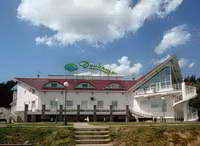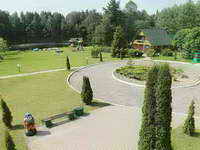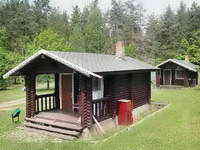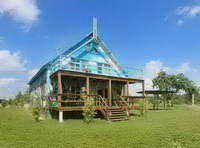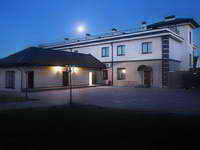National park Braslav Lakes
Braslav Lakes national park
The object of the rest located on the territory of the National park Braslav Lakes:
Article's map
- General information
- History
- Nature
- Walking across «Zamkovaia gora»
- Braslav
- Braslavskie museums
- Lakes of Braslav region
- Architectural and historical sights of Braslavshchina
- Fauna
- About national park
- Useful links
General information
National park «Braslavskie ozera» is located in the northwest of Belarus in the territory of a geographical province with the poetic name «Belarusian Poozere».
It was created by the decision of the Cabinet of Ministers of Belarus ¹ 440 on the 10th of August, 1995. It was established for the preservation of unique ecosystems, effective and fuller use of recreational possibilities of natural resources of Braslav region and a natural complex of Braslav lakes group as historically developed landscape and genetic fund of vegetation and fauna which are typical for «Belarusian Poozerje».
The natural complex of the national park is considered as the standard of landscapes of Baltic territories. Ridges, hills and deep falls which divide them create typical for the young glacial relief countur of tops, slopes, convex and concave parts.
The landscapes of the wildlife preserve «Interlake» have exclusively high value. because they contain almost all forms of the relief that is widely-spread in «Belaruskoe Poozerie». Ñapes deeply pressing in the lakes, high moraine islands, and also large boulders and their congestions make the landscape of the region more diverse.
The unique ecological environment of this lake-land contains the traces of the passed glacial age. The greatest lakes: Driviaty, Snudy, Strusto, Voiso, Voloso Northern, Nedrovo, Berezha, Daubli, Poteh, etc. lie among hills. Each of them differs has individual features and originality. The total size of the territory of lakes is about 183 square kilometers. On the lake Strusto is located the island - Chajchin (square of 1,6 sq. km), thet has internal reservoir - a small lake. Lake Voloso Southern - the deepest in the territory of National park. Its maximum depth is about 40,4 m at the area of 1,2 sq. km. The lake is famous for its unusual cleanliness of water and its transparency. The region flora contains more then 800 kinds of plants, from them about 20 are rare and now disappearing. They are included in the Red Book. In the territory of National park are widely presented typical and unique zoocomplexes and groupings of separate valuable representatives of fauna.
History
The
development of travelling and recreation in region has been started since the
second half of the 20th years of the last century. Today in Braslav and its
outskirts office workers and students from Vilno, Warsaw has begun to come.
First it was convenient to come here by train, later by bus Vilno - Braslav. In
the early thirties the children camps were organised in Braslav in summer.
On the bank of the lake Drivjaty the big landing stage for yachts and boats with
a dance hall, viewing and sports platforms were bouilt here. The regattas were
regularly arranged on the lake. In this place were opened tennis courts, glider
club and different other objects of infrastructure.
People who were fond of winter sports began to come in Braslav. Here they could
do skiing, skating, iceboats, hunting. After war the travelling development of
Braslav region was slowed down.
Nature
The lakes are the real wealth of the national park. There are more than 200 lakes here. In the territory of national park there is a number of small rivers and streams concerning to the pool of Zapadnaya Dvina river and its left tributary Disna.
In the system of lakes of the national park and its security zone, except lakes
of Braslav group, stand out some lakes. In the east – Obsternovskaia group; in
the north – group Obabie, in a souther – Boginsky, Opsovsky, Bogdanovsky lake
groups, in the west – group Buzhe.
In territory of national park prevail superficial and shallow lakes (depth to 15) . About third of lakes have depth
15 – 25 m and more. Among them lakes Northern and Southern Volos, which depth reaches 40 m. The most part of lakes
is connected in one system by channels and the river Drujka.
The difficult relief and heterogeneity of soils have caused a variety of vegetation. As a part of natural vegetation of the national park which occupies about 60 % of its territory, there are woods (42 %), meadows (22 %), bogs (16 %) and bushes (20 %).
About a quarter of the area of the park occupy forests. Forests in the park territory settle down as the isolated territories: Boginsky, Vidzovsky forest dacha, forest Belmont, Drujsky forest dacha and forest Boruny.
The flora of the national park estimates over 800 kinds of vascular plants, including 20 which are protected. Among them there are linneia northern, cloudberries, crowberry black, a naiad small, aldrovanda bubbly, etc.
Walking across «Zamkovaia gora»
The Zamkovaia gora is an ancient site of an ancient settlement, the most remarkable historical monument of Braslav which is situated in the city center.
Outside the mountain Zamkovaia gora represents a high hill with flat top and abrupt enough slopes. Still about hundred years ago, when Braslav was absolutely small place, the mountain Zamkovaia gora invariably impressed visitors with its splendour. The site of ancient settlement towered over several tens of wooden small houses which were restricted near its bases as a reminder on nice days of history of Braslav.
The Braslav site of ancient settlement is one of the biggest in Belarus.
The most ancient pages of history of Braslav were read by orchiologiests in the materials found in the site of ancient settlement. The first inhabitants chose well protected by lakes hill in VIII-IX centuries of our era. It were representatives of one of Baltic tribes - natives of the local places. In the beginning of XI century Braslav was the sphere of interests of the Polotsk princedom which was strengthening its power.
The fortress repeatedly was exposed to an attack from outside Baltic tribes. In XVI century more than a half of all dwellers of Braslav lived outside of mountain Zamkovaia gora.
There are a lot of legends connected with this mountain. They tell about subways which in case of need helped to deduce besieged in the lock to the lake Drivjaty. They also tell about different vaults where were hidden treasures including gold knightly armor. There are many stories devoted to mysterious shade of the princess which sometimes appeared in underground galeries.
Little by little the city has grown round the lock. It was named Braslav - the city of Brasa.
In some old publications about Braslave mountain Zamkovaia gora compared to a volcano crater.
Braslav
In the center of Braslov prevail small wooden with gardens. Here and there it is possible to meet old buildings of the beginning of the century which are made from red brick and with their bases made from a lump stone. In places of new building there are many inexpressive cottages and faceless high-rise buildings. The character of building of the central hilly part of Braslav is unforgettable. It stretched from the mountain Zamkovoya gora to the West. The streets are twisting and short there. In this part of Braslav the building at first was conducted on the most convenient falls.
Not far from the mountain there are some streets with the uncomman names: Sandy, Zamkovaja, a lane of Podgornyj. Here there was the street Narbutovsky, unfortunately, not preserved its name. Now it is Kirov street. In the heart of it, nearby to mountain Zamkovoya gora, there is a building of the former clinic constructed in 1906. It was the Project of a clinic provincial architect A.Shpakovsky.
ÊThe church of Christmas of Divine Mother is located on a small eminence surrounded with old maples. On the same place is settled down the first wooden Catholic temple of XV century. The church has been constructed on means of the statesman known during this period Vojteha Monivida, one of heroes of Grjunvaldsky fight of 1410.
The church interior is decorated by a sculpture and icons of the beginning of the XX-th century. The internal lattice of the central entrance is made by smiths from Deep. It is very beautiful. The main relic is stored in a temple altar of Braslav church - an icon of Mother Divine Braslavsky which is considered wonder-working.
Opposite to a church there is a building of an orthodox temple - Uspenija Presvjatoj Bogoroditsy's churches. It is constructed also in 1897. The first church in Braslav was erected in the beginning of XV century by the permission of prince Vitovta. The building of a temple made from brick and covered with plaster, is a monument of architecture of pseudo-Russian style. The interior of a temple decorated with more than 100 icons is very rich. The three-storied iconostasis is executed in the end of XIX century by presumably Kiev masters. In the first circle near to an imperial gate there is a temple icon "Assumption". The second circle make an icon "Last Supper" and images of the sacred. In the third circle icons of prophets of Ilya and Moiseja, and also two icons of a passionate cycle are placed: «cross Execution», «Removal from a cross».
Great Patriotic War, is located on northern suburb Braslava along the street Dzerzhinsky. Here there is a memorial on a place of mass executions of inhabitants of the Braslavsky ghetto. Since summer of 1942 Hitlerites have destroyed in this place more than 6 thousand persons. In center Braslava, around streets on 1st of May and Jurenko, is an old city cemetery. The oldest burial places are dated the middle of XIX century the Cemetery reflects ethnic features of Braslava and vicinities. Here there are Catholic, orthodox parts, places of a compact burial place of Russian conservatives and Tatars.
Braslav museums
Fans of history and olden time will find a lot of interesting in a museum of local lore in an exposition opened in 1988 the Museum. It is located in the wooden private residence constructed in 30th years of XX century under private printing house. The building has a remarkable three-level lay-out. The small areas of six exposition halls and an exhibition facility most approach for individual visiting.
There is rich enough archaeological section. In it materials of researches of neolytic parking under Braslavom, Iron Age sites of ancient settlement, burial places, settlements of the period of the Polotsk princedom, medieval cultural layers of places are presented.
Subjects from burial places VII - XI centuries are interesting because they testify to balto-slavic character of the population of Braslavshchiny during this period, about interference of two cultures.
At excavation of settlements of the period of the Polotsk princedom (Braslav, Drisvjaty, Maskovichi) are revealed many exhibits testifying to high level of material culture. Among the most interesting - female ornaments from bronze, glasses, bones, crosses-relikvarii,
On show-windows elements of arms XI-XIII centuries, XVI-XVII centuries, materials about strengthenings of Braslavshchiny of the period of Grand duchy Lithuanian are presented, sorts of noble family, events of revolts 1794, 1863, wars of 1812 the Separate complex of materials is devoted Drue who was the most considerable occupied and shopping center Braslavshchiny.
Interest of visitors is caused by an ethnographic exposition in which the interior of an old country log hut is restored, various household subjects and instruments of labor are shown.
Events of the beginning of the XX-th century are widely reflected. The great attention is given the First World
War. About three years the territory of Braslavshchiny was arena of opposition of the Russian and German armies.
The rich material tells about the period of 1919-1939 when the edge was a part of the Polish state.
The separate hall is devoted Great Patriotic War events. Certificates of tragical destiny of the Jewish
population of region, retaliatory operations of invaders against the peace population of guerrilla zones,
activity of the Braslavsky antifascist underground, formation and development of guerrilla movement,
emancipating fights in July, 1944 are exhibited
The visitor of a museum will find in an exposition materials about reprisals of 40 50th years, the well-known natives of Braslavshchiny. The separate complex is devoted to the known Belarus artist Stavrovo Peter Sergievichu (1900 1984).
In two halls of a museum exhibits from thematic collections which display traditions of national culture of region are placed. Products of weavers, potters, smiths, carvers, masters of weaving, and also musical instruments are exposed, characteristic for national musicians of the end XIX - 1st half XX century the exposition Part in these halls is taken away under various household subjects XIX - íà÷. XX centuries: hours, ware etc.
Ìóçåé òðàäèöèîííîé êóëüòóðû - ýòî ìóçåéíûé êîìïëåêñ, êîòîðûé ïðîäîëæàåò ôîðìèðîâàòüñÿ. Â áëèæàéøåå âðåìÿ ïëàíèðóåòñÿ îòêðûòü îòäåëû òðàäèöèîííîé êóõíè è ýêñïîçèöèþ «Çàåçäíûé äâîð».
Now the Museum of crafts located in a building of a mill XX century. It is the attractive building from a chipped stone and a brick. The exposition is opened in 1995. It reflects the directions of national creativity most traditional for Braslavshchiny - weaving from a rod, straws, other natural materials, weaving, pottery. In these directions educational classes for children and adults are opened. The visitor has possibility not only to examine expositions, but also thanks to open interiors to get acquainted with the equipment of classes, student's works, to observe training process.
Braslav lakes
In vicinities of Braslav there is one of the largest lake groups in Belarus, known as Braslav lakes. In its structure thre are more than 50 lakes. Their total area exceeds 130 square kilometers, and the pool area makes more than 800 square kilometers.
The majority of lakes on which take place tourist routes, has the difficult configurations, strongly cut up coastal lines forming set of deep gulfs, peninsulas - the whole water labyrinth.
As a rule, routes of travel on Braslavsky lakes begin with coast of the lake Drivjaty largest on Braslavshchine and fifth on the size in Belarus. Its area of 36,1 sq. km. The hollow was stretched at length almost on 10 km, reaching the maximum width of 4,5 km. Extent of a coastal line of 37,6 km. Despite the considerable sizes of lake, its average depth of only 6 meters, maximum - doesn't exceed 12 meters. The underwater part reminds a hilly relief - deep-water places alternate with extensive raisings, numerous banks. Skilled fishermen without effort list names more than fifty banks: the White road, Sacred, the Edge, Mikutsky, Leshchevka, Long, Zamkovaja, Lodochka, Thick, Okunevka, Cherepy, Malka, Plain, Podrechnaja.
The lake is opened to the winds of any direction quite often lifting big enough waves. In cloudy windy weather water gets a lead shade. This color, foamy crests of waves, noise of a surf at coast - just as on the sea. Quiet lake Drivjaty you will see not so often, but thanks to intensive hashing its water quickly enough gets warm and happens slightly more warmly, than in the next, deeper lakes. Besides water is well sated with oxygen that is very essential to the majority of kinds of fishes. For a long time the lake Drivjaty was considered as the most fishy in all region.
Now fish value of lake has considerably decreased. Pike perch is caught in very small amounts. From valuable kinds there are a bream, a pike, a burbot.
On the western suburb of the Ratsky Pine forest there is a site of ancient settlement and êóðãàííàÿ group VI-XI of centuries. The location of a site of ancient settlement can be defined on three wide shaft and a ditch.
In Ratsky Pine forest nearby to the lake coast there are open-air cages of National park «Braslavsky lakes».
The ake Raka with the area of 0,8 sq. km has the narrow extended hollow. The maximum depth here bigger than in Drivjaty - 17 meters. In some places the lake has high hilly coast.
In northern part Melkoy luki the river Drujka originates. Through 52 kilometers it runs into Zapadnaya Dvina.
Within Braslav group of lakes Drujka is deep, with a quiet current and low. Near to the source of Drujka runs into small lake Tsno. The area of this reservoir of 0,5 sq. km, length of the extended hollow of 1,1 km, average depth of 1,3 meters.
In a northwest direction of coast Tsno are gradually narrowed - and here already in them continues the current the river Drujka. It some times is smoothly bent between low hills and soon deduces in lake Nespish. From here Braslavsky lakes are divided on two branches - east and western. The east includes lakes Nespish, Nedrovo, Potseh, in western - Vojso, Bolojso, Strusto, Snudo, Northern and Southern Hair.
The squire of lake Nespish is about 4,26 sq. km. The length extended from the north on the hollow south exceeds 4 km at the maximum width of 1,4 km. Average depth - 3,2, maximum - 6,3 meters. The twisting coastal line more than 16 kilometers forms in the extent some gulfs so deeply pressing in a land that they can be accepted for separate reservoirs in east part of lake.
On the lake there are 14 islands, mostly small (total area 0.3 sq. km.). Several islands in the southern and northern parts are suitable for parking. In the southeastern part of the lake is remarkable island Monastery (Convent).
Nedrovo Area - 3.72 square meters km, the length of the valley - 3 km. The average depth of about 5 meters, maximum - more than 12 meters. Lake has a very tortuous coastline, where the length of 15 kilometers, round valleys and picturesque hilly slopes. Along the northern coast stretches for 2,5 km unusual shape ridge distance resembles roach back of a fantastic animal.
Duct, bypassing the western extremity of the ridge, leads to the lake Potseh. Due to the narrow winding valley longer than 2.5 km is the lake resembles a large lowland river. It is interesting that with the help of the Finno-Ugric languages, the name of the lake can be translated as "Bay", "lake bay" - is a very accurate description. Lake area 1.35 square meters. km, average depth of 3.4 meters, maximum - 9.1. Shape of the lake formed esker ridge along the southern coast and Kamov hills on the north shore.
On the east coast are fairly large village Slobidka, which boasts beautiful natural surroundings. In summer there is always a lot of truckers, vacationers.
Lake Potseh closes the eastern branch of the group. To continue your journey, you should return to Nespish, in south-western part of which is the duct leading to the lake Voiso. Not possible that his name could come from the Baltic bases with semantic meaning "pale", "weak". And indeed, this pond looks paler than the neighboring ones. The western shore of his flat, covered with bushes, in some places swampy. The opposite - a high steep slopes. Voiso Area - 4.88 square meters. km, average depth - 4,5 m, maximum - 9. The length of a meandering coastline, forming several small bays, 15.2 km. Basin length of almost 4 kilometers stretches from northwest to southeast along the prevailing winds here.
Long, similar to a river channel connects the lake Voiso Strusto, which begins immediately with a broad, up to several hundred meters band reeds. According to some claims, the name of the lake - is typical of Finno-Ugric, but there is no convincing its interpretation. With the help of Baltic languages the name translates as "reed". Lake Strusto - one of the largest in Braslavskaya group and, perhaps, among the most picturesque. Its area - 13 square meters. km, but a large number of islands (a total of 7, the total area of 2.58 sq. km.), reed and reed thickets, lots of bays, headlands, peninsulas, formed by a meandering coastline, break the water surface in some areas. Average depth of the lake - 7,3 m.
Among many islands differ Lake Strusto and Chaychin which are located in central part. Chaychin - his area of 1.62 square meters. km - the second largest island of Belarus. Prior to reduce the level of lakes in the 30 years of its northern part was a separate island Yurkov. Chaychin, Yurkov and the neighboring island of Chauveau were tiny archipelago, which housed the village of Island Strusto. In 1931 its population was 27 people, there were six yards.
The island Chaychin has a bizarre shape coastline: the deep bays with clean sandy beaches, visiting far into the lake of the peninsula, the narrow isthmus. The surface of Chaychin diverses: hilly places alternate with lows, the pine forest is replaced by alder or birch grove. On the island you can see rare for Belarus birchwood. Juniper here reaches 3-4 meters in height.
Lakeside Strusto characterized by a wide variety of landscape. East Coast - a short, flat, with a strip of bush near water. The south and west - forests. High-rolling and unforested ridge along the northern shore makes Strusto resemblance to some of the northern lakes. Highest hill called Mount Beacon. This is one of the highest points Braslavskaya hills and beautiful sightseeing point.
Snudy lake area, the second largest in Braslavskaya group, is 22 square meters. km, the length of the valley 8,8 km. The average depth of 4.9 m, maximum - more than 16 meters. The coast is very indented. The coastline is 35 kilometers. As in most other cases, there is no shortage of versions of the origin of the name of the lake.
North Severny volos is almost completely surrounded by woods and is very picturesque. Its area is 4.21 square meters. km, the length of the valley 3,5 km.
I the lake is very clean and clear water (Secchi 6 meters). In calm weather in the shallows can be sen the smallest details on the bottom. At some sites it is covered with boulders, which placers from the boat like the ruins of some ancient buildings.
Near the northern shore of the lake is a nature sanctuary - Volos'ka stone. This block of granite rappakivi length 3.7, width 1.9, height 1.4 meters, weighing 14 tons.
Architectural and historical sights of Braslavshchina
Not only the nearest neighborhood Braslav, but the whole area has interesting architectural and historical monuments.
Within the national park there are well represented archaeological monuments, including settlement and burial grounds in Braslau, near the villages Ahremovtsy, Bochin, Mouth, by far, Drisvyaty, Zhvirbli, Zazony, Opsa and other mounds and burial mounds belong to the period from the VII century. BC. er. until early feudalism and belong dneprodvinskoy culture, culture primed ceramics and later. Folk architecture represented a fine example of peasant dwellings - venochnym palace in the village Ikazń, built in 1009, as well as several barns of the last century and manhole tent in Braslau. Monumental religious architecture represented by a series of stone and wooden churches of XVII - beginning of XX century.: Baroque Bernardine monastery complex in the town Druja, neo-Gothic church in Braslau, neo-Gothic church in the village Slobidka and wooden churches in the village boundary and far. Orthodox churches architecture described in Braslav, Drisvyaty and Ikazn constructed in a formal pseudo style.
At 35 kilometers from Braslav is one of the most remarkable historic settlements Braslav - urban village Druja. In the XVII - beginning of XX century Druja considered a city.
Historical and architectural monuments of the city were very badly affected during the wars of the XX century. In the riverbed Druyki preserved rare monument Epigraphy XII century - one of Borisovs stones. On a large boulder carved six-pointed cross and the inscription. p> Above the floor, immersed in green, there are te buildings of the village church tower of Holy Trinity. Bernardine church belonged to the Order and was erected in 1643 - 1646 years of the means of Kazimierz Lew Sapieha (1609-1656), podkantslera Grand Duchy of Lithuania, the founder of the Department of Law of Vilnius Academy. The temple is situated on the bank of the Daugava River.
On the shore of the Western Dvina River in the town center is the Annunciation Church, a monument of architecture of the late XVIII-XIX centuries. The temple was badly damaged during the struggle with religion,
Íà ïðàâîñëàâíîì êëàäáèùå ìîæíî îñìîòðåòü íåáîëüøóþ äåðåâÿííóþ öåðêîâü ñâ. Ãåîðãèÿ. Îäíîñðóáíûé îñíîâíîé îáúåì óêðàøåí áàøíåé-çâîííèöåé ñ øàòðîâûì çàâåðøåíèåì. Ïîñòðîåíà öåðêâóøêà â XIX âåêå.
Fauna
In the park Braslav live about 45 species of mammals, 200 bird species, 10 amphibian species and 6 species of reptiles. The structure of fauna of the park is particularly valuable avifauna. In its territory inhabited by up to 85% of the total composition of the birds nesting on the territory of Belarus. Of greatest interest are bird communities of islands of large lakes, bogs and forests. Group of birds that have commercial value and is rich in both types of relations (Tetraonidae, shorebirds, waterfowl game), and in quantitative terms (here the focus up to 15% of the total stock of game birds lake area).
Extremely rich is fauna of aquatic invertebrates, which live in the water column - and zooplankton living at the bottom of bodies of water zoobenthos. In the zooplankton of lakes, such as hair, Snudy, Strusto, Sito, rare species of animals - relics of the Quaternary period, trapped in fresh water from marine fauna during the last glaciation - a planktonic crustacean limnokalyanus and inhabitant of the bottom layers of water - a relict mysid. They are very sensitive to water quality and can serve as indicators of the degree of water pollution. A distinctive feature of the benthos Braslav is the presence of relict invertebrates such as pontoporeya, amphipod Pallas in lakes Drivyaty, Richie, Snudy, Strusto, hair. Aquatic organisms of plankton and benthos - the staple food of fish inhabit the waters. As part of the ichthyofauna of the national park of about 30 species of fish. European eel, which was once a native species, maintains its strength through artificial stocking. Almost all lakes are widely distributed pike, roach, bream, ukleya, perch. Less common minnow, interviews, catfish and bullhead. Only in deep lakes with clear water and high oxygen content are found whitefish and smelt.
About national park
The uniqueness of this region is the presence of the cleanest lakes, framed by picturesque hills covered with pine forests. In the north - west of the north of Belarus has one of the most beautiful lake systems - Braslav, whose title gave the city Braslau. Located in the heart of lakes. Beauty and aesthetic value of this edge, attach a fancy lace from more than 30 lakes connected by channels, as well as the picturesque hills covered with woods, separating one from another lake.
The total area Braslavskaya is 114 sq km lake system. The largest lakes are Drivyaty, Snudy, Strusto, Voiso, Nedrovo, Nespish. This group and became the nucleus of the National Park Braslav, which was founded in August 1995.
Useful links:
- The program of tours of the National Park Braslav

